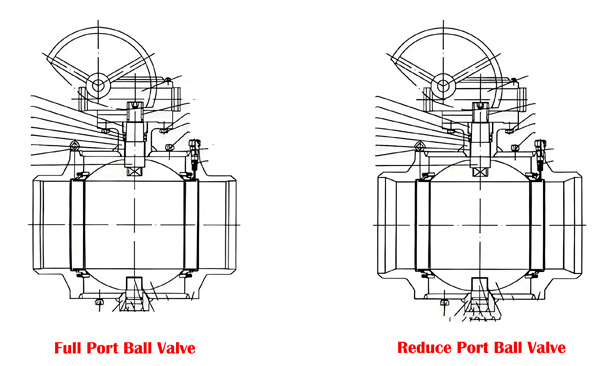Full Port vs Reduced Port Ball Valves: Key Differences and Selection Guide
Ball valves are critical components in fluid control systems, classified into two main types: full port (full bore) and reduced port (reduced bore). Understanding their differences ensures optimal performance and cost efficiency in industrial applications.

Defining Full Port vs Reduced Port Ball Valves
- Full Port Ball Valve: The valve’s inner diameter matches ≥95% of the pipeline’s nominal diameter (e.g., a 2-inch valve has a 50mm flow path).
Tips: When selecting a ball valve, the full-bore 2 Inch ball valve has the valve size written as NPS 2.
- Reduced Port Ball Valve: The inner diameter is ≤85% of the pipeline’s nominal diameter (e.g., a 2-inch valve has a ~38mm flow path).
Tip: When selecting a ball valve, the reduced-bore 2 Inch ball valve has the valve size written as NPS 2 x 1-1/2
Key Structural Differences
| Feature | Full Bore Ball Valve | Reduced Bore Ball Valve |
|---|---|---|
| Flow Path Design | Equal to pipeline diameter; no narrowing | 1-2 sizes smaller than pipeline |
| Flow Efficiency | Zero flow restriction; minimal pressure drop | Higher resistance than full bore |
| Valve Sizing (NPS) | Matches pipeline (e.g., NPS 2) | Denotes reduction (e.g., NPS 2 × 1½) |
| Weight & Compactness | Heavier; robust construction | 30% lighter; space-saving design |
Performance and Application Comparison
| Factor | Full Bore Ball Valve | Reduced Bore Ball Valve |
|---|---|---|
| Ideal Media | Viscous fluids (crude oil, slurry), pigging systems | Gases, water, low-viscosity fluids |
| Flow Requirements | Maximum flow with minimal resistance | Controlled flow; adjustable capacity |
| Typical Use Cases | Main pipelines (oil/gas), cleaning systems | Branch lines, budget-sensitive projects |
| Pressure Drop | Near-zero resistance; ideal for long pipes | Higher local pressure drop |
| Cost Efficiency | Higher upfront cost | 30% lower cost; reduced pipe load |
How to Choose the Right Ball Valve
Prioritize Full Bore If:
1. Handling viscous/slurry media or requiring pigging.
2. System demands maximum flow with minimal pressure loss.
3. Pipeline cleaning/maintenance is routine.
Choose Reduced Bore When:
1. Working with gases or low-viscosity liquids.
2. Budget constraints exist; lightweight valves are preferred.
3. Flow control and space optimization are critical.
Why It Matters
1. Full Bore Valves eliminate flow restrictions, reducing energy costs in long-distance transport.
2. Reduced Bore Valves offer cost savings (up to 1/3 cheaper) and efficient flow control for compact systems, while reducing structural load on pipelines.
Post time: Jun-25-2025






